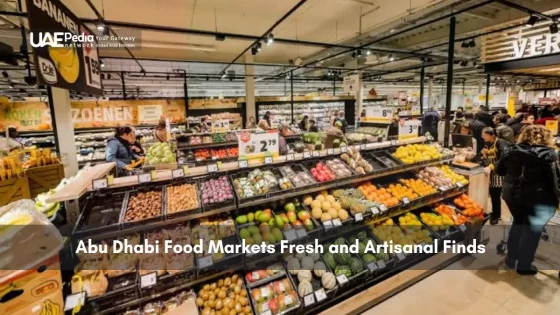Did you know 78% of travelers prioritize local markets over malls when seeking authentic cultural experiences? The capital’s vibrant hubs prove why. Here, saffron-scented alleys meet modern artisan stalls—a living mosaic where centuries-old trading traditions shake hands with today’s gourmet trends.
Walking through these spaces feels like flipping through a sensory scrapbook. Vendors arrange pyramids of ruby-red pomegranates beside jars of honey dripping with golden promise. Nearby, craftsmen shape pottery using techniques unchanged for generations. Every corner whispers stories—of fishermen hauling dawn catches, spice traders blending secret mixes, and families sharing recipes across folding tables.
This isn’t just shopping. It’s a passport to understanding how tradition fuels the city’s heartbeat. Locals haggle playfully over dates while visitors sample cardamom-spiced coffee. You’ll find Emirati grandmothers teaching millennials to fold samosas, their laughter weaving through the hum of barter and banter.
- Markets blend heritage craftsmanship with contemporary culinary innovation
- Seasonal produce and handmade goods create multisensory exploration
- Cultural exchanges thrive between residents and global explorers
Introduction to the Vibrant World of Abu Dhabi Food Markets
In a city where skyscrapers touch the clouds, the real heartbeat thrives at ground level. Generations-old trading customs meet artisanal coffee stands and hand-painted ceramics here. You’ll find grandmothers sharing family recipes beside chefs sourcing organic za’atar—a living tapestry woven from threads of past and present.
An Overview of Local Market Culture
These bustling hubs pulse with energy from dawn till dusk. At Souk Central, the air hums with vendors calling out today’s catch while saffron threads glow like liquid sunshine in wooden crates. Three elements define the experience:
- Time-honored rituals: Watch fishermen auction their dawn haul at Mina Zayed Fish Market
- Modern flair: Sip cold-brew karak chai at minimalist stalls serving global street food twists
- Shared spaces: Families debate the juiciest dates while culture enthusiasts chat with henna artists
Embracing Tradition and Modernity
The magic lies in seamless contrasts. Traditional mud-brick arches frame vegan dessert shops offering camel milk chocolate. “My grandfather sold fish here—now I supply sushi-grade tuna to hotels,” shares Ali, a third-generation vendor. QR codes hang beside handwritten price tags, creating an atmosphere where every visit delivers comfort and surprise.
Pro tip: Arrive early for the freshest seafood. Later sections reveal how to haggle like locals while respecting tradition. Ready for more? Let’s explore what makes these places unforgettable.
The Rich History Behind Abu Dhabi’s Bustling Markets
Step into any market here, and you’re walking through centuries of trade history compressed into vibrant alleyways. Souk Central Market’s coral-stone walls—built in the 1970s—still echo with the rhythm of Bedouin merchants bartering for dried limes. Today, those same corridors hum with digital payment systems beside baskets of Omani halwa.
At Mina Zayed Fish Market, dawn auctions mirror practices from the pearl-diving era. “My father taught me to spot the freshest hamour by its gills,” says Rashid, a fourth-generation vendor. His stall now supplies Michelin-starred chefs while maintaining handwritten ledgers. This duality defines the capital’s living marketplace DNA.
Three threads weave through these spaces:
- Date palm traders preserving ancient irrigation techniques
- Street food carts simmering saffron-infused biryani from family recipes
- Fishmongers using TikTok to showcase the day’s catch
Notice how vendors balance tradition with innovation. At the dates market, you’ll taste varieties like khalas and lulu—each with stories of desert survival. Nutritionists praise their energy-boosting properties, but locals cherish them as symbols of hospitality. Meanwhile, Gen-Z entrepreneurs blend date syrup into cold brew lattes nearby.
These markets aren’t frozen in time. They’re conversation pits where haggling over turmeric root coexists with contactless payments. As you explore, you’ll feel history’s pulse in every transaction—a reminder that progress here walks hand-in-hand with heritage.
Immersive Local Culture at Traditional Souks
What if shopping could transport you through time? Traditional souks answer this daily, wrapping visitors in geometric shadows cast by coral-stone archways. These spaces breathe history—their very walls etched with stories of pearl divers and spice caravans.
Iconic Architecture and Heritage
Look up. Grand wind towers—ancestors of modern AC—still crown some rooftops, their latticework funneling desert breezes into shaded alleys. Intricate arabesque patterns adorn wooden doors, each curve whispering tales of artisans who shaped them centuries ago. “These designs aren’t just decoration,” explains Leila, a third-generation textile vendor. “They’re love letters to our land’s resilience.”
Three architectural marvels define these spaces:
- Mashrabiya screens filtering sunlight into starry patterns
- Hand-carved stone foundations using ancient Nabati techniques
- Calligraphy-adorned gates quoting poetry about hospitality
The Unique Blend of Old and New
Watch a teen influencer film a TikTok while sipping karak chai from a dented thermos. Nearby, a silver-haired merchant weighs saffron using brass scales unchanged since his grandfather’s era. This dance between eras thrills visitors:
“I came for Instagram shots but left with henna art and life advice from a 70-year-old pottery master,” shares California traveler Marco.
The magic lives in contrasts. You’ll find:
- QR codes hanging beside hand-painted price tags
- Artisan workshops flanking specialty coffee counters
- Folk musicians performing near pop-up vegan bakeries
Every corner pulses with shared humanity. Locals debate the best olive oils while helping tourists wrap scarves properly. Come evening, the scent of oud mingles with fresh-baked khubz as families gather under fairy lights. Ready to wander? Your story here begins at the next stall.
Exploring the Iconic Souk Central Market
Imagine a place where the scent of frankincense guides you through arched passageways lit by geometric skylights. Welcome to Souk Central Market—a living museum of commerce where Bedouin trading spirit meets 21st-century convenience. Coral-stone walls and carved wooden shutters frame stalls bursting with treasures, from handwoven camel-hair rugs to saffron threads glowing like captured sunlight.
This labyrinth rewards curious explorers. Turn left for spice merchants sharing family recipes, right for jewelers crafting silver khanjars (traditional daggers). The air thrums with friendly banter—vendors might offer cardamom coffee as you admire Persian carpets. Pro tip: Wear comfortable shoes and let yourself get deliciously lost.
| Product Type | Traditional Finds | Modern Twists |
|---|---|---|
| Textiles | Hand-dyed abayas | Emirati-inspired tote bags |
| Spices | Omani frankincense | Pre-mixed shawarma blends |
| Jewelry | Bedouin silver coins | Gold-plated smartphone cases |
Time your visit like a pro: arrive at 9 AM to watch shopkeepers unveil their wares, or swing by at 4 PM when golden light bathes the courtyard. Locals know Wednesdays offer the best selection before weekend crowds descend. Remember—bargaining’s expected, but keep it playful. A smile works better than hardball tactics here.
Don’t miss the date stall near the south entrance, where 15 varieties sit ready for sampling. Nearby, a hidden spice grinder from the 1980s still operates daily. “My grandfather sold dates here when camels parked outside,” laughs vendor Khalid. Today, his stall accepts Apple Pay beside baskets of khalas dates.
Whether you’re hunting embroidered cushions or Instagram-worthy snacks, this market delivers stories as rich as its goods. Every purchase connects you to generations of traders—and maybe sparks your next great adventure.
Fresh Produce and Authentic Flavors at Al Mina Fruit & Vegetable Market
Ever watched a sunrise while squeezing ripe figs? At Al Mina, dawn’s first light reveals crates of emerald cucumbers and ruby strawberries—still glistening with morning dew. Farmers from nearby oases unpack seasonal treasures as regulars arrive with reusable bags, ready to haggle over the day’s harvest.
The air buzzes with Arabic chatter and the snap of fresh okra. Vendors stack pyramids of heirloom tomatoes beside baskets of ghaf leaves used in traditional stews. “Taste this—sweet as honey!” urges Fatima, offering a slice of golden mango from her family’s farm. Seasonal rotations mean winter brings blood oranges, while summer dazzles with dragon fruit.
| Product Category | Traditional Finds | Modern Innovations |
|---|---|---|
| Fruits | Omani limes | Pre-cut tropical mixes |
| Vegetables | Desert-grown zucchini | Organic salad kits |
| Herbs | Wild sidr honey | Ready-to-cook spice packs |
Arrive by 7 AM to snag just-picked herbs still smelling of earth. Vendors gladly explain how to roast loomi (dried lime) for soups—but don’t leave without sampling date-sweetened labneh. Bargaining’s expected, yet polite: start at 60% of the asking price, then meet halfway with a smile.
This isn’t just grocery shopping. It’s where grandmothers swap pickle recipes with expat chefs, and TikTokers film rainbow radish hauls. The scent of jasmine flowers mixes with espresso from a pop-up cart—proof that tradition and trend coexist deliciously here.
Diving into the Mina Zayed Fish Market Experience
Ever tasted salt spray on your lips while selecting tomorrow’s dinner? Mina Zayed Fish Market answers this daily. Before sunrise, fishing dhows dock with silvery hauls—hamour flapping, red snapper glistening. Crews sort catches using methods unchanged for generations, while digital screens update prices in real time.
Savoring Fresh Seafood Delicacies
Vendors arrange ocean treasures like edible art. Emerald-hued kingfish lie beside towers of pink shrimp. “Choose your catch, and we’ll grill it with loomi spice right here,” offers Samira, a vendor whose family has sold seafood here since 1982. Don’t miss machboos samak—a fragrant rice dish simmered with local spices.
Three tips for foodies:
- Arrive by 7 AM for tuna auctions
- Try oyster shots drizzled with date syrup
- Request “market style” grilling at onsite kitchens
Experiencing the Market’s Energetic Atmosphere
This place thrums like a living heartbeat. Ice crunches underfoot as vendors call out today’s specials. The scent of brine mixes with sizzling garlic butter. Watch fishermen mend nets between sales—their hands moving as rhythmically as the tides.
Modern touches blend seamlessly. QR codes link to recipes, while solar-powered cold rooms keep catches fresh. Sustainability shines too—80% of vendors now use biodegradable packaging. As one regular notes: “It’s where my grandfather’s wisdom meets my daughter’s eco-conscious values.”
Guided tours unlock hidden gems, like behind-the-scenes fish cleaning stations. Come hungry, leave with stories—and maybe a crab claw necklace from a chatty vendor.
Discovering Unique Handcrafted Treasures at the Carpet Souk
Ever felt history beneath your fingertips? At the Carpet Souk, generations-old patterns come alive under your palms. This maze of shops hums with artisans knotting wool in rhythms unchanged for centuries. “My great-grandfather wove for Bedouin tribes—now we ship worldwide,” shares Fatima, whose family runs a stall displaying geometric masterpieces.
Sunlight filters through wooden lattices, illuminating vibrant sadu rugs beside minimalist modern designs. Each piece whispers stories—of desert caravans, royal commissions, and mothers teaching daughters sacred weaving techniques. Three elements define this shopping experience:
- Silk-thread Persian carpets with botanical motifs
- Palm-fiber floor mats dyed using natural indigo
- Emirati wedding dowry chests draped in camel-hair textiles
Bargaining here is an art form. Start by admiring craftsmanship, then offer 40% below asking price. Vendors often counter with mint tea and tales about their products’ origins. “This rug took eight months to weave,” explains Ali, unfolding a crimson-and-gold runner. “But for you? Special price.”
| Style | Traditional | Contemporary |
|---|---|---|
| Materials | Camel wool, natural dyes | Recycled fabrics, metallic threads |
| Patterns | Tribal symbols | Abstract cityscapes |
| Sizes | Prayer mats | Wall-to-wall installations |
Let your nose guide you—the scent of raw sheep’s wool mingles with sandalwood incense. Pause where vendors demonstrate knot-counting, or watch teens photograph rainbow textile walls for Instagram. Every corner offers tactile magic, from plush pile carpets to breezy linen throws.
This isn’t just shopping. It’s stepping into living heritage—one thread at a time.
Indulging in the Sweet Delights of the Dates Market
Ever bitten into a date so fresh it tastes like desert sunshine? Welcome to a labyrinth of amber-hued treasures where khalas varieties glisten beside plump Medjool giants. This isn’t just shopping—it’s a tactile journey through 60+ date types, each with textures ranging from caramel-soft to satisfyingly chewy.
Vendors arrange their jewels in woven baskets, urging samples with proud smiles. “Try this one—it’s like nature’s energy bar!” says Ahmed, offering a fardh date stuffed with almonds. Locals know dates symbolize hospitality here, served with bitter Arabic coffee to balance sweetness. You’ll spot grandmothers teaching kids to pit dates using methods unchanged for generations.
Three tips for smart browsing:
- Seek glossy skins without sugar crystals—signs of freshness
- Ask about rare varieties like kheneizi, prized for floral notes
- Counter initial prices with friendly haggling—it’s expected
| Variety | Flavor Profile | Best For |
|---|---|---|
| Khalas | Butterscotch, honeyed | Direct snacking |
| Medjool | Rich, syrupy | Stuffing with nuts |
| Sukkari | Creamy, mild | Dessert recipes |
Notice how vendors blend tradition with flair—QR codes link to recipe videos while handwritten signs share harvest dates. The air thrums with laughter as shoppers compare finds. “My grandfather ate dates before pearl diving,” shares regular visitor Mariam. “Now I add them to smoothies.”
Whether you’re fueling hikes or craving natural sweets, this spot delivers culture and nutrition in every bite. Pro tip: Grab a date-filled ma’amoul cookie from the corner bakery—your taste buds will thank you.
Global Influences and Local Artistry in Abu Dhabi Markets
Where else can you find Italian leather shoes sharing space with hand-stitched camel saddles? The capital’s markets thrive on this cultural alchemy—spaces where global techniques dance with heritage craftsmanship. Vendors here reimagine tradition daily: a pottery maker might use Japanese raku firing for Emirati-inspired vases, while textile artists blend Bedouin patterns with Scandinavian minimalism.
Stroll past French patisseries neighboring stalls selling khameer bread baked in clay ovens. Luxury skincare brands sit beside organic oud oil distilled using ancient methods. This fusion isn’t accidental—it’s a response to savvy shoppers craving both authenticity and innovation. “My customers want designs that honor our roots but fit modern apartments,” explains Layla, a third-generation carpet seller now collaborating with Milanese interior designers.
Three tips for navigating these hybrid spaces:
- Visit mid-morning when international shipments arrive—prime time for unique finds
- Ask artisans about their creative process—many happily share cross-cultural inspirations
- Compare prices at stalls blending imported/exclusive items with locally made goods
The energy peaks near sunset. Watch a Japanese knife sharpener work beside an Emirati blacksmith shaping ceremonial coffee pots. QR codes link to maker stories—from Ethiopian coffee farmers to Dubai-based chocolatiers. Every purchase supports this web of global exchange.
Come hungry for discovery. Whether you’re hunting limited-edition sneakers or palm-frond baskets, these markets prove creativity knows no borders. Ready to explore? Your next conversation starter awaits at the spice stall doubling as a micro-art gallery.
Abu Dhabi Food Markets: A Hub for Diverse Cuisines
What if your taste buds could globe-trot without leaving one bustling alley? The capital’s culinary scene turns this fantasy into reality, blending Emirati grandmothers’ recipes with Korean BBQ pop-ups. Here, saffron-infused biryani steam mingles with za’atar-dusted pizza aromas—a flavor collision that defines this foodie paradise.
Start with golden luqaimat dumplings drizzled with date syrup—a sweet nod to Bedouin hospitality. Then follow your nose to sizzling Iranian kebabs or Filipino adobo simmering in coconut vinegar. “My stall’s been serving machboos since 1991,” says Mariam, stirring a giant pot of spiced rice. “Now I make vegan versions for Gen-Z customers.”
Three must-try mashups:
- Shawarma tacos with harissa mayo
- Matcha-karak latte fusions
- Date-glazed salmon nigiri
| Traditional | Modern | Fusion |
|---|---|---|
| Camel meat stew | Sushi-grade tuna bowls | Turmeric latte cheesecake |
| Freshly baked khubz | Cold-pressed juices | Za’atar popcorn |
Pro tip: Chat with vendors about their spice blends—many share tasting samples. The man selling Omani halwa might slip you a cardamom chocolate truffle. Night markets near the corniche offer live cooking demos where chefs reveal secret techniques.
This isn’t just eating—it’s decoding centuries of trade routes through flavor. Every bite connects you to Phoenician merchants, Persian poets, and today’s boundary-pushing chefs. Ready to taste the world?
Exploring the Enchanting Night Markets of Abu Dhabi
What transforms ordinary shopping into starlit theater? As daylight fades, the capital’s markets shed their daytime rhythm for a moonlit ballet of flavors and crafts. Twinkling fairy lights replace sunbeams, casting golden halos around stalls serving saffron ice cream and hand-painted lanterns.
Experience Under the Arabian Stars
Families gather around fire pits roasting marshmallows dipped in date caramel. Nearby, artisans demonstrate pottery throwing under LED-lit palm trees. The air thrums with oud melodies from live musicians—modern beats layered over traditional rhythms. Three elements define these after-dark adventures:
- Glow-in-the-dark henna designs blending ancient symbols with neon hues
- Pop-up theaters screening Emirati folktales with holographic effects
- Midnight spice auctions where bidders win rare blends using smartphone apps
Modern Trends Meet Tradition
Watch grandmothers share ghahwa recipes through TikTok Live while teens queue for matcha-karak fusions. QR codes on woven baskets link to stories about weavers’ desert ancestors. “We’ve sold dates here for 40 years,” says vendor Amal, motioning to her contactless payment terminal. “Now night owls from Tokyo to Toronto join our sunset tastings.”
Pro tip: Arrive by 7 PM to catch golden hour photo ops. Stay past 9 PM when street performers ignite the plaza with fire dances. Whether you’re hunting limited-edition ceramics or cardamom-infused churros, these luminous labyrinths promise moonlit magic—no passport required.
Architectural Wonders and Lively Market Stalls
What if buildings could whisper stories while you shop? The capital’s market spaces blend time-crafted designs with buzzing energy. Coral-stone arches curve like desert dunes above spice stalls, while sunlight filters through geometric screens onto piles of saffron. Every structure here serves dual purposes—sheltering goods and sparking wonder.
Traditional souks showcase craftsmanship in their bones. Look for wind towers funneling breezes through alleyways and hand-carved wooden shutters framing textile displays. At the Old Souk, vendors arrange pottery beneath vaulted ceilings that once hosted pearl traders. Modern counterparts surprise too—glass-fronted malls reflect date palms while housing pop-up vegan bakeries.
Three design details to spot:
- Mashrabiya screens casting star-shaped shadows on spice sacks
- Recycled-material stalls shaped like traditional fishing boats
- LED-lit pathways guiding night shoppers past heritage walls
Layouts here master crowd flow. Narrow lanes funnel visitors past jewel-toned rugs, then open into sunlit courtyards where locals sip karak chai. “We position stalls so scents of fresh bread hit you first,” explains a vendor at Mina Plaza. Comfort meets curiosity—shaded seating areas nestle beside artisan workshops.
Join a sunrise architecture tour to catch golden light on terracotta tiles. Guides reveal hidden carvings of falcons and dhows—symbols of resilience. Whether marveling at century-old stonework or Instagramming futuristic canopies, every angle offers visual poetry. The true magic? Structures here don’t just house culture—they breathe it.
Family-Friendly Adventures in Abu Dhabi’s Market Scene
Looking for a place where kids can touch history while you shop? The capital’s markets transform into playgrounds of discovery—safe spaces where little hands knead dough beside master bakers and colorful stalls spark curiosity. Stroller-friendly lanes wind past spice sacks doubling as scent guessing games, making cultural immersion feel like playtime.
At Al Mina’s fruit section, vendors invite families to press fresh pomegranate juice together. Nearby, henna artists teach simple patterns to wide-eyed visitors. “My kids learned more here than from textbooks,” shares tourist mom Rachel, watching her daughter shape clay pots with a local artisan. Three spots shine for young explorers:
- Dates Market: Free tastings turn into sweet geography lessons
- Carpet Souk: Interactive weaving demos with rainbow threads
- Night Markets: Glow-in-the-dark treasure hunts under fairy lights
Smart planning maximizes fun. Pack reusable water bottles—many stalls offer free refills. Seek shaded courtyards with seating when energy dips. Weekend mornings bring puppet shows near the textile quarter, while Thursdays feature storytelling sessions about pearl divers.
Facilities cater to all ages:
| Need | Solution |
|---|---|
| Hungry toddlers | Quick-bite zones with fruit skewers |
| Restless teens | Instagram scavenger hunt maps |
| Cultural curiosity | Guided tours ending in craft workshops |
Between bargaining for embroidered pillows and sampling date ice cream, families stitch memories into the city’s vibrant fabric. Every laugh shared over sticky baklava becomes part of your collective adventure—proof that exploration thrives here, one generation at a time.
Essential Shopper Tips for Navigating the Market Maze
Want to shop like a pro? The secret lies in balancing preparation with spontaneity. Arrive at 7:30 AM to beat crowds and watch vendors unveil their freshest goods. “Early birds snag the juiciest dates,” laughs Samira, a third-generation spice seller. Weekday mornings offer calmer browsing, while sunset brings lively energy perfect for people-watching.
Master the art of friendly haggling. Start by complimenting the product, then offer 60% of the asking price. Vendors often meet halfway—especially if you buy multiple items. Watch for these quality markers:
- Handwoven textiles with tight, even stitching
- Spices stored in airtight containers away from sunlight
- Firm fruits without soft spots or dull skin
| Time Slot | Strategy | Goal |
|---|---|---|
| 7-9 AM | Focus on perishables | Fresh picks |
| 11 AM-1 PM | Chat with relaxed vendors | Deal hunting |
| 4-6 PM | Explore hidden corners | Unique finds |
Split your visit into zones. Spend 30 minutes in each section—spices first, then crafts, saving snacks for last. Locals suggest: “Follow the grandmothers. They know which stalls offer samples.”
“Bring reusable bags and small bills—it shows respect for our craft,” advises Ahmed, a ceramic artist. His tip? Ask vendors for their favorite lunch spot nearby. You’ll gain a meal recommendation and potential discount.
End your tour with a cold karak tea. Let the experience unfold naturally—the best treasures often hide behind crowded stalls. Now, go weave your own story through the vibrant aisles.
Insider Insights on Arts, Music, and Street Performances
Have you ever stumbled upon a drum circle while browsing handmade ceramics? The capital’s stalls double as cultural stages where artisans become performers and every purchase comes with free entertainment. This is where shopping bags sway to folk rhythms and credit cards tap beats against oud melodies.
Live Performances That Bring Markets to Life
Catch spontaneous drum circles near textile stalls or impromptu poetry slams by spice vendors. Thursdays spark ayyala dance troupes twirling sticks near date stalls—their white robes swirling like desert winds. “We perform where our grandparents traded pearls,” says musician Khalid, tuning his rababa between sets.
Three ways to catch the magic:
- Follow henna-scented air to calligraphy demos at sunset
- Listen for daff frame drums near pottery workshops
- Check digital boards at market entrances for scheduled shows
| Performance Type | Traditional | Modern Fusion |
|---|---|---|
| Music | Oud recitals | Electro-Arabic remixes |
| Dance | Harbiya stick dances | Hip-hop meets folk |
| Art | Henna hand painting | LED-lit sand art |
Discovering Traditional Crafts and Calligraphy
Watch masters transform palm fronds into baskets as they share Bedouin survival stories. At the calligraphy corner, artists dip gold-tipped pens in indigo ink to script your name in kufic style. “Each stroke honors our ancestors’ wisdom,” explains artisan Layla, framing verses from 14th-century poets.
Pro tip: Join free workshops at these hotspots:
- Clay-throwing sessions behind the spice souk (10 AM daily)
- Arabic coffee pouring lessons near textile stalls
- Fabric dyeing using natural pomegranate skins
These experiences turn casual browsing into cultural immersion. You’ll leave with more than products—you’ll carry stories etched in ink and rhythm.
Wrapping Up the Journey Through Abu Dhabi Markets
Ready to turn market maps into treasure trails? Our exploration reveals how these hubs stitch together centuries of living heritage with tomorrow’s trends. From dawn fish auctions to neon-lit spice stalls, every corner blends time-honored rituals with modern surprises.
Visitors discover more than products—they collect stories. Imagine swapping grilling tips with third-generation vendors while scanning QR codes for recipe videos. Families bond over date tastings as artisans demonstrate weaving techniques unchanged since pearl-diving days. Each visit becomes a masterclass in cultural exchange.
Pack these insights for your adventure: arrive early for secret deals, chat with creators about their craft, and let curiosity guide you. Bookmark this guide to revisit pro tips on haggling respectfully or finding hidden dessert gems. Whether you’re hunting handwoven textiles or fusion street bites, the capital’s markets promise sensory lessons in resilience and reinvention.
Now’s your moment. Wander where tradition dances with innovation, and every purchase carries a legacy. Your next unforgettable experience awaits—just follow the scent of freshly ground cardamom.
Arrive early morning (6–9 AM) for the freshest catches and to watch the lively auction action. Evenings are quieter but still buzz with locals grabbing dinner ingredients.
Absolutely! Many spots like Souk Central and night markets offer shaded stalls, sweet treats, and interactive activities. Kids love watching artisans craft pottery or sampling sticky date honey.
Polite bargaining is part of the fun in carpet and craft stalls—start at 30–50% below the asking price. However, fresh produce and seafood markets usually have fixed rates.
Beyond tasting 200+ date varieties (try Khalas or Dabbas!), you’ll learn about their cultural significance. Many vendors offer free samples paired with Arabic coffee—a sweet Emirati tradition.
Yes! Night markets like those near the Corniche thrive after sunset. Expect food trucks, live oud music, and cooler temps—perfect for grabbing karak chai or saffron-infused desserts.
Dress modestly (cover shoulders/knees), ask permission before photos, and greet vendors with “As-salam alaykum.” A smile and patience go a long way in building friendly exchanges!



















